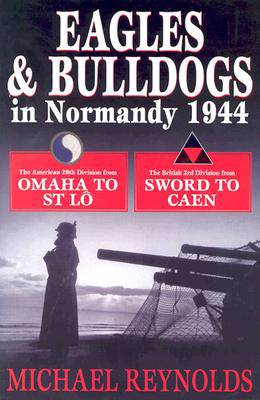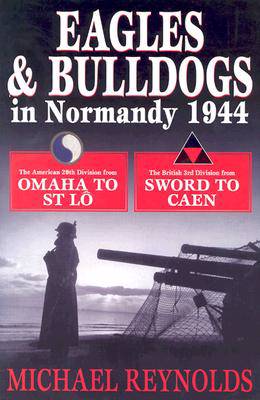
Je cadeautjes zeker op tijd in huis hebben voor de feestdagen? Kom langs in onze winkels en vind het perfecte geschenk!
- Afhalen na 1 uur in een winkel met voorraad
- Gratis thuislevering in België vanaf € 30
- Ruim aanbod met 7 miljoen producten
Je cadeautjes zeker op tijd in huis hebben voor de feestdagen? Kom langs in onze winkels en vind het perfecte geschenk!
- Afhalen na 1 uur in een winkel met voorraad
- Gratis thuislevering in België vanaf € 30
- Ruim aanbod met 7 miljoen producten
Zoeken
Eagles and Bulldogs in Normandy, 1944
The American 29th Infantry Division from Omaha Beach to St Lo and the British 3rd Infantry Division from Sword Beach to Caen
Michael Reynolds
Hardcover | Engels
€ 45,95
+ 91 punten
Uitvoering
Omschrijving
This is the story of two Infantry Divisions during the first weeks of the Normandy campaign. With battle cries of '29 - Let's Go!' and '3rd Division - Drive On!' the American 29th and British 3rd fought their way into OMAHA and SWORD beaches on D-day and then inland towards their respective objectives - the major communication centers of St. Lô and Caen.
After describing the agonies suffered by the Americans on 'Bloody OMAHA' and the difficulties experienced by the British in overcoming the concrete strong points sited in depth behind the SWORD beach, the author follows both Divisions as they tried to break through the German defenses. Their initial moves were quickly countered by a well trained and astute enemy - in the case of the Americans by infantry and paratroopers in the dense 'hedgerow country' covering the approaches to St. Lô, and in the British by the Panzers and Panzer-Grenadiers defending Caen in the open country to its north.
It was to take the GIs nearly six weeks to reach their objective, whilst the Tommies were forced into a concurrent holding operation that in many respects resembled the trench warfare hell of World War One. The main part of Caen was eventually captured by the British and Canadians on 9 July and St. Lô by the Americans nine days later. By then two Allied Divisions had suffered more than 10,000 casualties, several thousand French civilians had been killed and the previously beautiful cities turned to rubble in a series of devastating air attacks.
Throughout this vivid account of infantry combat, readers will be able to compare and contrast the leadership qualities of the various commanders and the tactics employed by the Americans, British and Germans; and they will surely marvel at the sheer courage of a generation that is rapidly passing away.
After describing the agonies suffered by the Americans on 'Bloody OMAHA' and the difficulties experienced by the British in overcoming the concrete strong points sited in depth behind the SWORD beach, the author follows both Divisions as they tried to break through the German defenses. Their initial moves were quickly countered by a well trained and astute enemy - in the case of the Americans by infantry and paratroopers in the dense 'hedgerow country' covering the approaches to St. Lô, and in the British by the Panzers and Panzer-Grenadiers defending Caen in the open country to its north.
It was to take the GIs nearly six weeks to reach their objective, whilst the Tommies were forced into a concurrent holding operation that in many respects resembled the trench warfare hell of World War One. The main part of Caen was eventually captured by the British and Canadians on 9 July and St. Lô by the Americans nine days later. By then two Allied Divisions had suffered more than 10,000 casualties, several thousand French civilians had been killed and the previously beautiful cities turned to rubble in a series of devastating air attacks.
Throughout this vivid account of infantry combat, readers will be able to compare and contrast the leadership qualities of the various commanders and the tactics employed by the Americans, British and Germans; and they will surely marvel at the sheer courage of a generation that is rapidly passing away.
Specificaties
Betrokkenen
- Auteur(s):
- Uitgeverij:
Inhoud
- Aantal bladzijden:
- 230
- Taal:
- Engels
Eigenschappen
- Productcode (EAN):
- 9781932033175
- Verschijningsdatum:
- 19/10/2003
- Uitvoering:
- Hardcover
- Formaat:
- Genaaid
- Afmetingen:
- 157 mm x 246 mm
- Gewicht:
- 625 g

Alleen bij Standaard Boekhandel
+ 91 punten op je klantenkaart van Standaard Boekhandel
Beoordelingen
We publiceren alleen reviews die voldoen aan de voorwaarden voor reviews. Bekijk onze voorwaarden voor reviews.









